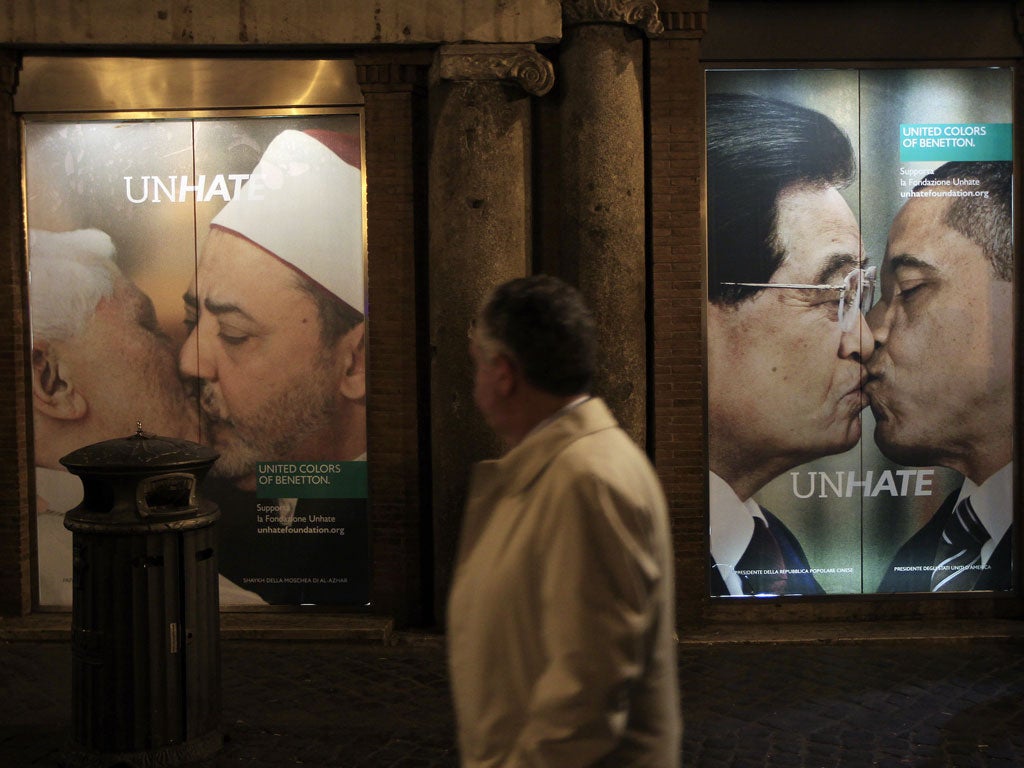Alice Jones: Faked pictures can't shock as much as real life
IMHO

Prince Harry fondles Pippa Middleton's pert behind on the royal balcony. John Galliano goose-steps around his studio in Nazi fetish gear. Simon Cowell gets an intimate wax. I've seen it all.
Not for real, of course, but on the pages of Exposed!, Alison Jackson's new book of cleverly faked photographs which use lookalikes and blurry zoom lens angles to show celebrities in all manner of compromising positions.
Elsewhere this week, Benetton unveiled its latest "Unhate" advertising campaign, which featured a Photoshopped image of the Pope snogging Ahmed Mohamed elTayeb, the imam of Cairo's al-Azhar mosque. The image was withdrawn within 24 hours after the Vatican denounced it as "unacceptable".
No matter, it had already done its job, causing a bit of a frisson around a shop best known for its woolly jumpers. A frisson is all they raise, though. In the age of Twitter and internet mash-ups, anyone with a laptop and a basic grasp of Photoshop can make and disseminate their own visual jokes or point-scorers instantly. Jackson's faked snapshot of Wayne Rooney trying on wigs before his hair transplant pale next to the footballer's own candid Twitpics of his post-operation pate. It's getting harder and harder to shock. Looking at Jackson's fakes and the Benetton adverts this week was like looking through a window on another, more innocent age.
It is, I suppose, the closest thing to being asked to play Hamlet - for the grizzled generation. Kenneth Branagh must have been thrilled to his tiptoes to be cast as Sir Laurence Olivier in My Week with Marilyn. There's a certain reflected glow that comes with playing the actor considered to be the finest of his generation.
In the film, out next week, he's joined by a bevy of British acting talent playing their garlanded predecessors - Judi Dench puts in a gorgeous grande dame turn as Dame Sybil Thorndike and Julia Ormond plays Vivien Leigh. Marilyn Monroe is played by the Hollywood starlet Michelle Williams, who brings her best pout and wiggle to the role. It's the second film of late to hurtle down the risky cinematic rabbit hole of artists playing artists. Woody Allen's Midnight in Paris was a carnival of cameos featuring Hemingway, Fitzgerald, Picasso and Dali, among many others.
Both films prove it's near impossible to avoid the big, campy pantomime wink to the audience when you have simulacra of real people flashing by on the big screen. And while it worked fine in Allen's charming folly, it's a bit grating in this latest film, which aspires to be rather more serious. The difference is that it's actors playing actors. The cast's suffocating reverence to their thespian forebears - slavishly imitating every last Larry eyebrow raise or Monroe kittenish lip twitch - made my teeth itch after a while. I walked out of the cinema resolved to order in the back catalogues of Monroe and Olivier immediately and spend some quality time with the real thing instead.
Never mind the 7.5p "austerity sandwich" - a slice of toast between two slices of bread - revealed this week by scientists to be the world's most economical lunch. This year, the trend is for luxe Christmas provisions, which are set to take conspicuous consumption to another level. First there was the world's most expensive mince pie, a £3,000 baked offering made with holy water from Lourdes, exotic spices and ambergris sugar, derived from the intestines of sperm whales. With a solid platinum coin in the centre (I'd rather have more filling, please). Then the Clawson Stilton Gold hit the shelves, a pungent, post-prandial wedge of cheese liberally flecked with edible gold leaf, costing £60 for a measly 100g. And this week, proving that money can buy you anything except, perhaps, good taste, Harvey Nichols reported strong sales for its gold food spray, intended to jazz up your boring old glitter-less turkey, at £25 a can. Oh, for the good old days when getting hold of Heston's "hidden orange" Christmas pudding was the only thing to worry about.

Join our commenting forum
Join thought-provoking conversations, follow other Independent readers and see their replies